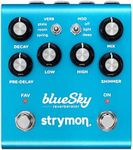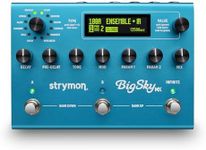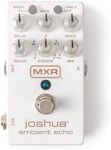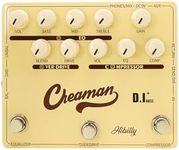Buying Guide for the Best Reverb Pedals
Reverb pedals are essential tools for guitarists and other musicians looking to add depth and space to their sound. They simulate the natural reverberation that occurs in different environments, from small rooms to vast cathedrals. When choosing a reverb pedal, it's important to consider how you plan to use it and what kind of sound you're aiming to achieve. Understanding the key specifications will help you make an informed decision and find the best fit for your needs.Reverb TypesReverb types refer to the different kinds of reverb effects that a pedal can produce, such as hall, room, plate, spring, and shimmer. Each type simulates a different acoustic environment. For example, hall reverb mimics the sound of a large concert hall, while spring reverb replicates the sound of vintage amplifiers. If you play a variety of music styles, a pedal with multiple reverb types might be ideal. If you have a specific sound in mind, choose a pedal that excels in that particular reverb type.
Decay TimeDecay time is the duration it takes for the reverb effect to fade away. This spec is crucial because it determines how long the reverb will linger after you play a note. Short decay times (0.5-2 seconds) are great for tight, controlled sounds, while longer decay times (2-10 seconds or more) create a more atmospheric and spacious effect. Consider the genre of music you play and the context in which you'll use the pedal. For ambient or experimental music, longer decay times might be preferable, whereas shorter decay times work well for more rhythmic and precise playing.
Mix ControlMix control allows you to adjust the balance between the dry (unaffected) signal and the wet (reverb-affected) signal. This is important because it lets you fine-tune how prominent the reverb effect is in your overall sound. A higher mix level means more reverb, while a lower mix level keeps the reverb more subtle. If you want the reverb to be a major part of your sound, you might prefer a higher mix setting. For a more understated effect, a lower mix setting is better.
Pre-DelayPre-delay is the time between the original sound and the onset of the reverb effect. This spec is important because it can help to maintain clarity and prevent the reverb from muddying your sound. Short pre-delay times (0-20 milliseconds) create a more immediate reverb effect, while longer pre-delay times (20-100 milliseconds) allow the initial note to be heard more clearly before the reverb kicks in. If you play fast, intricate passages, a longer pre-delay can help keep your notes distinct. For a more cohesive and blended sound, a shorter pre-delay might be preferable.
Tone ControlTone control allows you to adjust the frequency response of the reverb effect, typically by boosting or cutting high and low frequencies. This is important for shaping the character of the reverb to match your desired sound. A brighter tone can add sparkle and presence, while a darker tone can create a warmer, more subdued effect. Consider the overall tone of your instrument and how you want the reverb to complement it. If your sound is already bright, you might prefer a darker reverb tone, and vice versa.
Bypass TypeBypass type refers to how the pedal handles your signal when the effect is turned off. There are two main types: true bypass and buffered bypass. True bypass means the signal passes through the pedal without any alteration when the effect is off, preserving your original tone. Buffered bypass, on the other hand, uses a buffer circuit to maintain signal strength, which can be beneficial if you use long cable runs or multiple pedals. If maintaining your pure tone is crucial, true bypass might be the way to go. If you need to preserve signal strength, consider a pedal with buffered bypass.






















